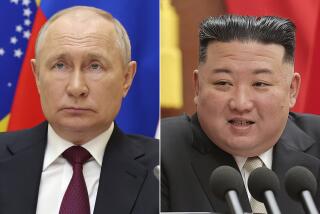U.S. Delegation to North Korea Opens Talks on Liaison Offices
- Share via
SEOUL — The first official U.S. delegation to go to North Korea began discussions Saturday on opening liaison offices, a major step toward establishing formal diplomatic ties.
Liaison offices in Washington and Pyongyang, North Korea’s capital, would also open a channel of communication that could speed resolution of the nuclear impasse with North Korea.
U.S. officials say relations will not be fully normalized unless North Korea lets in inspectors to see for themselves whether the North has been secretly building nuclear weapons at clandestine installations.
A simultaneous round of technical talks on nuclear issues began Saturday in Berlin.
The United States has never had diplomatic relations with North Korea since its founding as a Communist state in 1948.
A similar pattern was followed with China. Former President Richard Nixon ended decades of U.S. isolation of China by opening liaison offices in Beijing and Washington. Former President Jimmy Carter subsequently established full diplomatic relations in 1979.
The U.S. delegation, led by State Department Korea specialist Lynn Turk, arrived in Pyongyang on Saturday and began preliminary discussions that evening, the North’s official Korean Central News Agency said.
The talks, expected to last through Tuesday, are to focus on technicalities such as mail delivery, office space and telephone service. South Korean officials believe the liaison offices will be opened by the end of the year.
In Berlin, U.S. and North Korean nuclear experts began discussions Saturday on helping North Korea get light-water reactors, which are safer and produce less weapons-grade plutonium.
The U.S. delegation also is expected to ask the North Koreans about the condition of about 8,000 corroding fuel rods they have removed from their one operating reactor.
The fuel rods provoked an international crisis because the North refused to let inspectors monitor their removal. If reprocessed, the rods could produce enough plutonium for about five atomic bombs.
More to Read
Sign up for Essential California
The most important California stories and recommendations in your inbox every morning.
You may occasionally receive promotional content from the Los Angeles Times.













